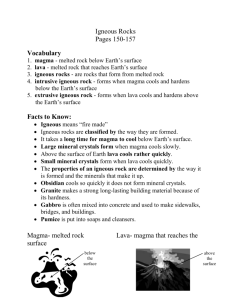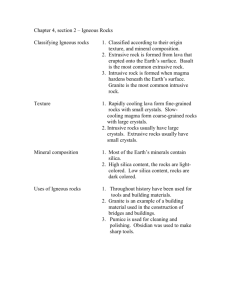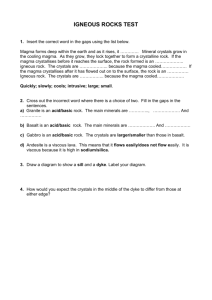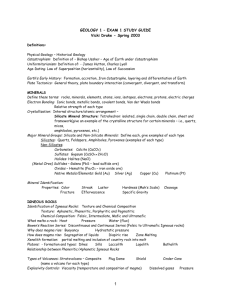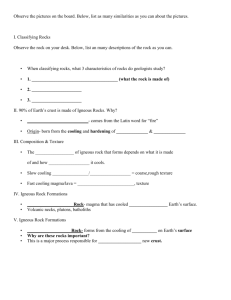Igneous Rock Lab
advertisement
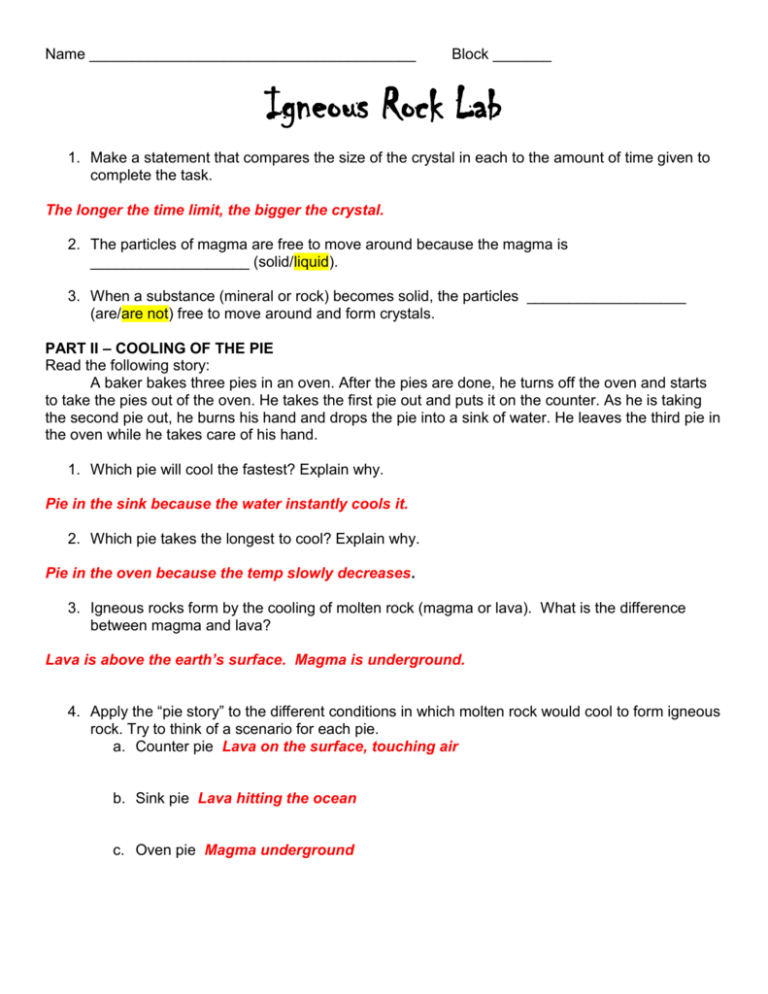
Name _______________________________________ Block _______ Igneous Rock Lab 1. Make a statement that compares the size of the crystal in each to the amount of time given to complete the task. The longer the time limit, the bigger the crystal. 2. The particles of magma are free to move around because the magma is ___________________ (solid/liquid). 3. When a substance (mineral or rock) becomes solid, the particles ___________________ (are/are not) free to move around and form crystals. PART II – COOLING OF THE PIE Read the following story: A baker bakes three pies in an oven. After the pies are done, he turns off the oven and starts to take the pies out of the oven. He takes the first pie out and puts it on the counter. As he is taking the second pie out, he burns his hand and drops the pie into a sink of water. He leaves the third pie in the oven while he takes care of his hand. 1. Which pie will cool the fastest? Explain why. Pie in the sink because the water instantly cools it. 2. Which pie takes the longest to cool? Explain why. Pie in the oven because the temp slowly decreases. 3. Igneous rocks form by the cooling of molten rock (magma or lava). What is the difference between magma and lava? Lava is above the earth’s surface. Magma is underground. 4. Apply the “pie story” to the different conditions in which molten rock would cool to form igneous rock. Try to think of a scenario for each pie. a. Counter pie Lava on the surface, touching air b. Sink pie Lava hitting the ocean c. Oven pie Magma underground PART III – APPLICATION Now, let’s think about real-life situations. 1. Where would molten rock take the longest to cool and change to solid? (on the surface, in the water, in the Earth?) In the earth. Intrusive 2. Considering your answer to #1, what can you deduce about the size of the crystal grains formed in this situation? Larger 3. Where would molten rock take the shortest time to cool and change to solid? (on the surface, in the water, in the Earth?) In the water. Extrusive 4. Considering your answer to #3, what can you deduce about the size of the crystal grains formed in this situation? Small crystals 5. Define the following: a. Intrusive Cools inside the Earth b. Extrusive Cools outside the Earth, on the surface Match these terms to the situations in questions #1 and #3. PART IV – USING TEXTBOOK INFORMATION Answer the following using Chapter 6 Section 2. 1. Magma can be classified in three ways: _mafic_______________________, _felsic______________________ and intermediate. 2. __Felsic______ magma is thick and slow-moving. It hardens into minerals such as quartz and orthoclase feldspar. It is generally __lighter____________ in color. 3. ___Mafic_________ magma is hotter and thinner. It hardens into minerals hornblende, augite, and biotite. It is generally _darker_____________ in color. 4. Intrusive igneous rocks form inside the Earth and cool (slowly, quickly) and thus form (large, small or no) crystals. Igneous rocks with large crystals are said to be (coarse, fine) grained igneous rocks. 5. Extrusive igneous rocks form on the Earth’s exterior and have (large, small or no) crystals. Extrusive igneous rocks with small crystals are said to have a _fine_______-grained texture. Extrusive igneous rocks with no crystals are said to have __glassy___________ texture. Some glassy textures have air holes. PART V – IDENTIFICATION Complete the following table using the rock kit samples. NUMBER Crystal size Fine=F Coarse=C 1,2,3 7 10 13 16 Location Intrusive=I Extrusive=E Color Light=L Dark=D Magma Type Felsic=F Mafic=M Rock Name C I L F granite C I D M gabbro F E D M basalt F E L F rhyolite F E D F obsidian Felsic even though dark in color. 19,20 21 F E L F pumice F E D M scoria





